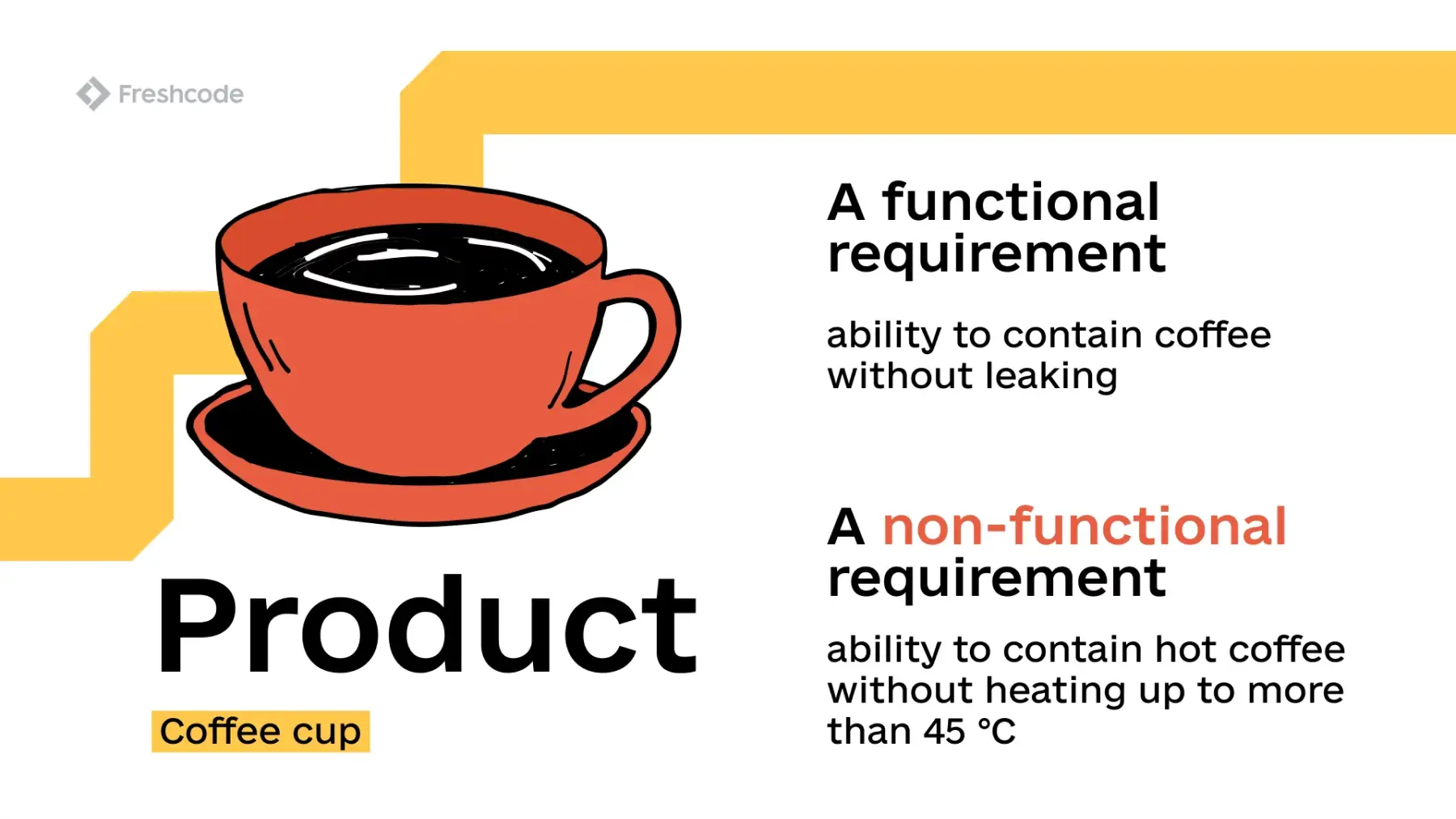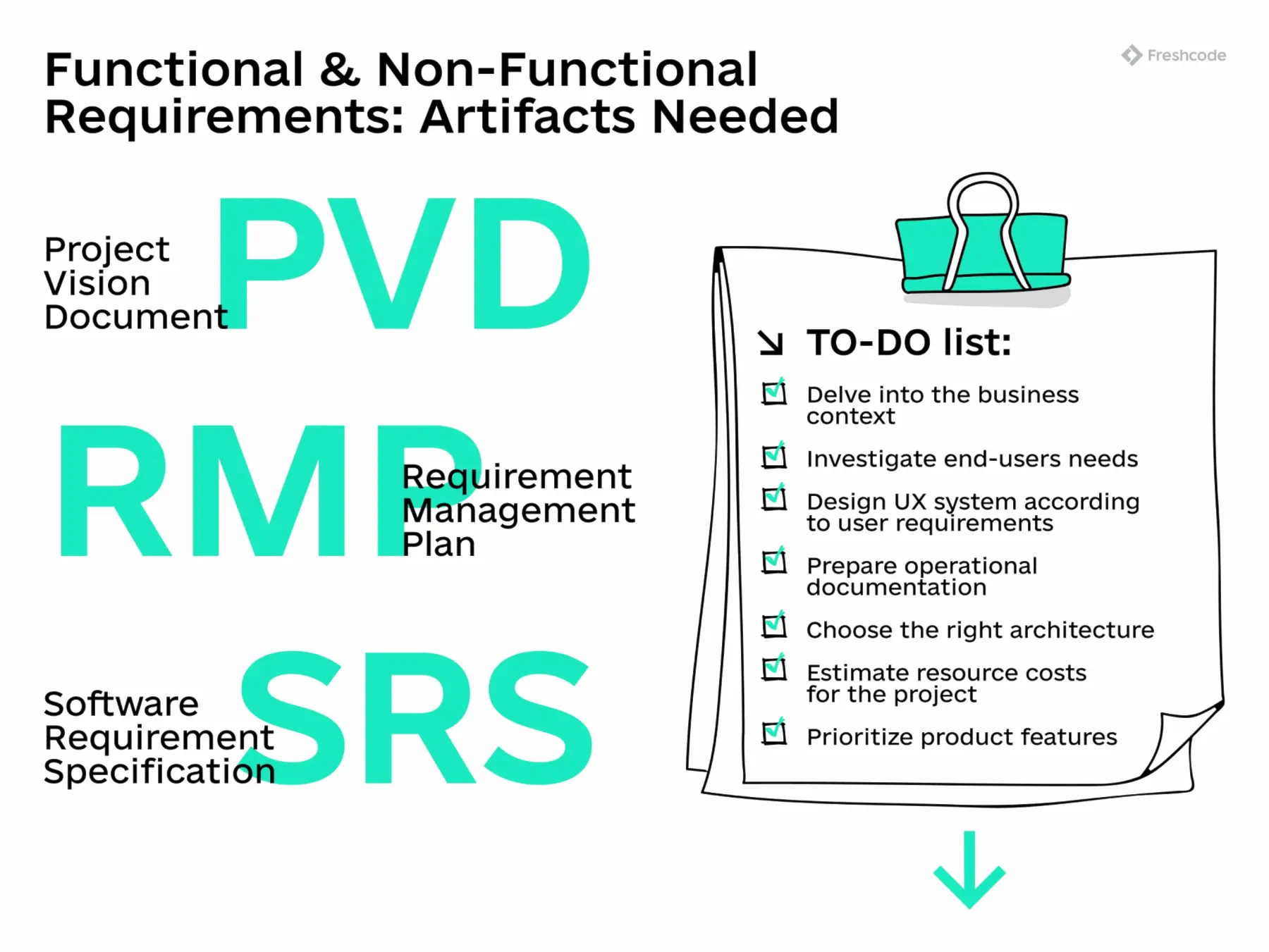What are functional requirements?
According to Statista, the primary reasons why startups fail are running out of funds (38%) and a lack of market need (35%). Flawed business models and skills mismatch are among other common pitfalls ⛔️
Many of these issues can be caused by one seemingly indirect thing — poorly written product requirements. Carefully designed and well-documented, they are essential to any project.
In the technology world, requirements are generally categorized into two types: <medium>functional and non-functional<medium>. They form a clear vision of the future product and serve as a roadmap for the development team. Both define <medium>desired system behavior<medium>, but the different sides of the last.
Let's break down these two.
<medium>Functional requirements<medium> define actions the product must provide to benefit users. Simply put, they describe:
{{rr21-1="/custom-block-to-blog/two-page"}}
These requirements are determined by the <medium>business needs and task analysis<medium>. They can be documented and described through the use cases.
To start with simple functional requirements examples, let's look at the... coffee cup.

Software requirements (functional and non-functional) are crafted by business analysts together with the development team, including software engineers, solution architects, and other IT specialists. Collaboration among stakeholders is crucial to ensure that all requirements accurately meet both users and business needs.
What is a non-functional requirement?
While a functional requirements specification is a kind of guide to the functions or tasks of the product, non-functional requirements (NFR) outline <medium>quality attributes<medium> designed to improve the product's functionality and user experience.

There are multiple -itys that serve as pillars for a <medium>good user experience<medium>. Defining them in advance provides you with a handy checklist to ensure you capture all critical requirements for the future product.
{{rr21-2="/custom-block-to-blog/two-page"}}
If you want to expand your software product while your business grows, saying 'product must be scalable' is not enough.
You have to be specific. For example, you can define this point as 'develop a system that can manage at least 100,000 users over the next 24 months, so customers don't experience app crashes and errors'.
A lack of prioritized non-function requirements can result in a vague project scope and mismatches between the project plan, client expectations, timeframes, and budget.
{{rr21-3="/custom-block-to-blog/two-page"}}
Difference between functional and non-functional requirements

If functional requirements define the product's key task (what it has to do), non-functional requirements determine how it should be done. The key difference is that the first ones are vital for the system; without meeting them, your product simply won't work.
Non-functions focus on a user experience; the system will work without them. The other thing is that it will lose its meaning — who would buy a guitar with a poor finish, strings that break too quickly, or no strap button? You can play such an instrument, but Gibson Les Paul will always outperform your product.
Don't take this in a way that working on non-functional requirements is less significant. Remember, <medium>user-centered and well-thought design<medium> rocks: if the app is not user-friendly, your project will not succeed just as well.
Therefore, only the yin-yang combination of functional and non-functional requirements matters — one cannot exist without the other.
How to write functional vs non-functional requirements?
Here, I want to guide you through the key points on the business analysis map and show why each stage is non-skippable in app development.
Business analysts are responsible for creating proper software requirements, both functional and non-functional. It requires careful preparation and a strong grasp of both technology and the market.
Writing software requirements is a complex task that brings important insights and practical outcomes. The process involves multiple stages, from initial meetings and discussions with stakeholders to structuring all the data into comprehensive requirements documentation.
{{rr21-4="/custom-block-to-blog/two-page"}}
{{rr21-5="/custom-block-to-blog/two-page"}}
All this documentation supports decision-making, builds a strong background for the product development, and speeds up time-to-market.
During requirements management, business analysts produce various artifacts to document and organize the software requirements effectively. Below, you can find more details about them.

{{rr21-6="/custom-block-to-blog/two-page"}}
{{rr21-7="/custom-block-to-blog/two-page"}}
How do we work with project requirements at Freshcode?
After years of analyzing and implementing various techniques and approaches, we have significantly simplified our requirement engineering process without compromising quality.
By deep understanding the needs of clients and users and creating a clear picture of the software product, we can find the strengths and weaknesses of each solution. Finally, after reaching an agreement with the client, the best possible solution is implemented. Our approach saves time and costs for both parties, preventing cases when work goes down the drain.
Here is a <medium>brief step-by-step guide<medium> on how we process product requirements, from the initial discussion to the final documentation:

A good business idea is a great start. From our side, we assist businesses in strengthening their projects with the best approaches, <medium>leveraging our technology expertise and experience in different business domains.<medium>
Our team is always ready to discuss a tech-savvy business strategy that aligns your business case. If you wish to learn more about Freshcode's expertise, our product delivery process, or get an initial project estimation, please contact us for a free consultation and a warm welcome 🙂
Also, you can contact our COO on Linkedin to get info about Freshcode solutions.
{{about-scherbak-red="/material/static-element"}}









